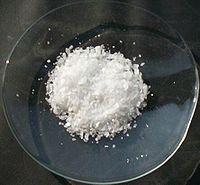
Photo from wikipedia
Controllable anionic redox for a transformational increase in the energy density is the pursuit of next generation Li‐ion battery cathode materials. Its activation mechanism is coupled with the local coordination… Click to show full abstract
Controllable anionic redox for a transformational increase in the energy density is the pursuit of next generation Li‐ion battery cathode materials. Its activation mechanism is coupled with the local coordination environment around O, which posts experimental challenges for control. Here, the tuning capability of anionic redox is shown by varying O local environment via experimentally controlling the density of stacking faults in Li2MnO3, the parent compound of Li‐rich oxides. By combining computational analysis and spectroscopic study, it is quantitatively revealed that more stacking faults can trigger smaller LiOLi bond angles and larger LiO bond distance in local Li‐rich environments and subsequently activate oxygen redox reactivity, which in turn enhances the reactivity of Mn upon the following reduction process. This study highlights the critical role of local structure environment in tuning the anionic reactivity, which provides guidance in designing high‐capacity layered cathodes by appropriately adjusting stacking faults.
Journal Title: Advanced Materials
Year Published: 2023
Link to full text (if available)
Share on Social Media: Sign Up to like & get
recommendations!